Each year, the New Zealand Book Awards for Children and Young Adults make for a massive occasion in the Aotearoa kids’ book world—move over Oscars, out of the way Silver Scrolls. This is our night.
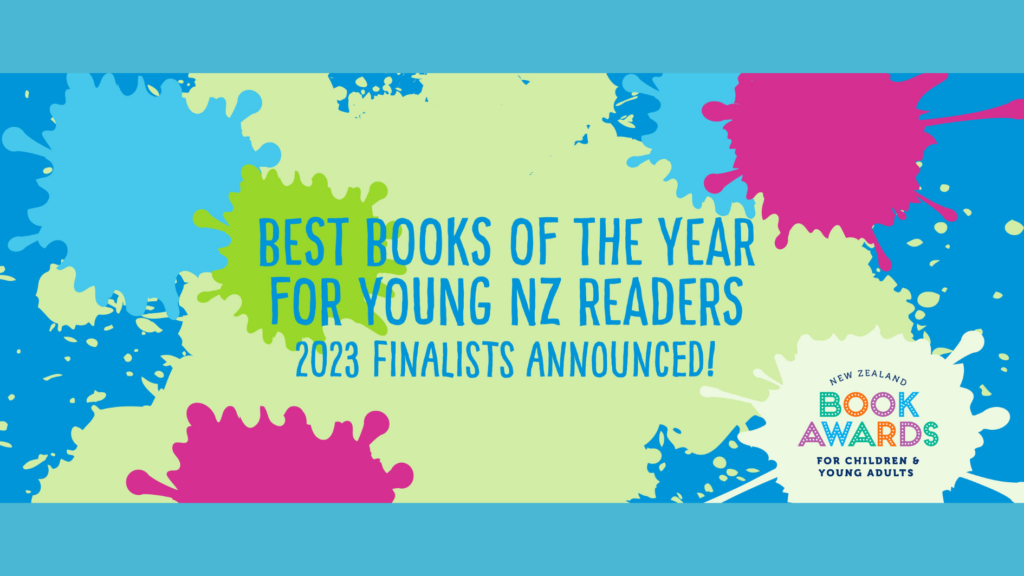
It’s my first year covering the NZCYA Awards and I was more than gleeful about receiving the embargoed list. It reminded me of my first experience of embargoed material, once upon a time when I worked in a Whitcoulls, holding forth on stacks and stacks of books about a certain well-known magical school-going wizard. Except all these richly New Zealand, wonderfully fresh titles are so much more exciting than flying broomstick soccer and nonsensical spells (I never read them, okay?), and I feel a special pride in knowing that our Aotearoa creatives are putting out such incredible books.
There’s something for everyone in these titles; rich representations of te ao Māori, science and nature, biography, Hunger Games-esque fiction, mysteries, personal journeys, history, humour, cute animals…it’s a smorgasbord of uniquely New Zealand material and it’s going to be a hard job for the judges. Convenor of judges Nicola Daly said, “This year’s entries reflect the changing nature of who we are as New Zealanders, with good helpings of humour and fantasy thrown in.”
Nicola Daly is judging with Daniel Buchanan, Feana Tuʻakoi, Maia Bennett, Ruth Paul, Ruki Tobin (convenor of the Te Kura Pounamu Award panel), Mihi Te Rina Henare, and Te Wairere Puāwaitanga O Te Whakaaro Ngaia. They also received feedback from students in 15 primary, intermediate and secondary schools from around Aotearoa, something which they say was an important part of their decision-making. Nicola Daly said, “We really appreciated the input from tamariki and rangatahi, which allowed us to see books from their perspective.”
The winners of each of the six main categories—Picture Book, Junior Fiction, Young Adult Fiction, Non-Fiction, Illustration and te reo Māori—take home $7,500 and are then in the running to be named the Margaret Mahy Book of the Year, with a further $7,500 prize money. In addition, the judges will award a Best First Book prize of $2,500 to a previously unpublished author or illustrator. We’ll be covering each category in more depth over the coming weeks before the award winners are announced on 10 August.
I am personally particularly enamoured with the quality of the illustrations and cover design of this year’s finalists. Mat Tait’s blue tones, Ant Sang’s crisp colouring, Isobel Joy Te Aho-White’s everything. Rose Northey did incredible justice to The Lighthouse Princess, after winning the Storylines Gavin Bishop Award for Illustration in 2021. I love the covers of Masher, Echo, Kidnap at Mystery Island, Eddy, Eddy, and He Raru ki Tai. Sylvia and the Birds feels like it was made for me (conservation! comics! birds!), and A New Dawn is such an important and beautiful book.
There are a few non-fiction and picture book titles I am sad to see didn’t make the cut this year. Matariki Around the World, by Rangi Matamua & Miriama Kamo, illustrated by Isobel Joy Te Aho-White is a wonderful introduction to how Matariki and other versions of it are celebrated around the world. Donovan Bixley’s Squawk is an excellent addition to the New Zealand bird book canon, and Wild Coasts by Ned Barraud is another high-quality nature and conservation book. (Okay, so maybe I’m a bit biased towards environmental books, but these definitely deserve a mention!). I think the picture book selection must also have been especially tough for the judges, since several come to mind that must have come close: The Grizzled Grist Does Not Exist, by Juliette MacIver and Sarah Davis, Moonlight Mission, by Laura Shallcress, and Have You Seen Tomorrow by Kyle Mewburn and Laura Bee Bernard.
It’s a journey, being a children’s writer and/or illustrator in New Zealand. We’re a small country competing with publishers and their books from around the world, but our country’s top books can stand up with the best of them. I want to take a moment to congratulate all our country’s writers, illustrators, editors, publishers, book designers, and traditionally and self-published creators for this last year of books, it’s a tough gig, and if you saw Creative New Zealand’s and NZ On Air’s infographic on creative professionals’ incomes, you’ll know we aren’t making millions! We’re in it because we love it, and we want to make books that people love.
So, without further ado, let’s celebrate this year’s finalists, who made some especially good books to love.
– Linda Jane Keegan
The Picture Book Award Finalists
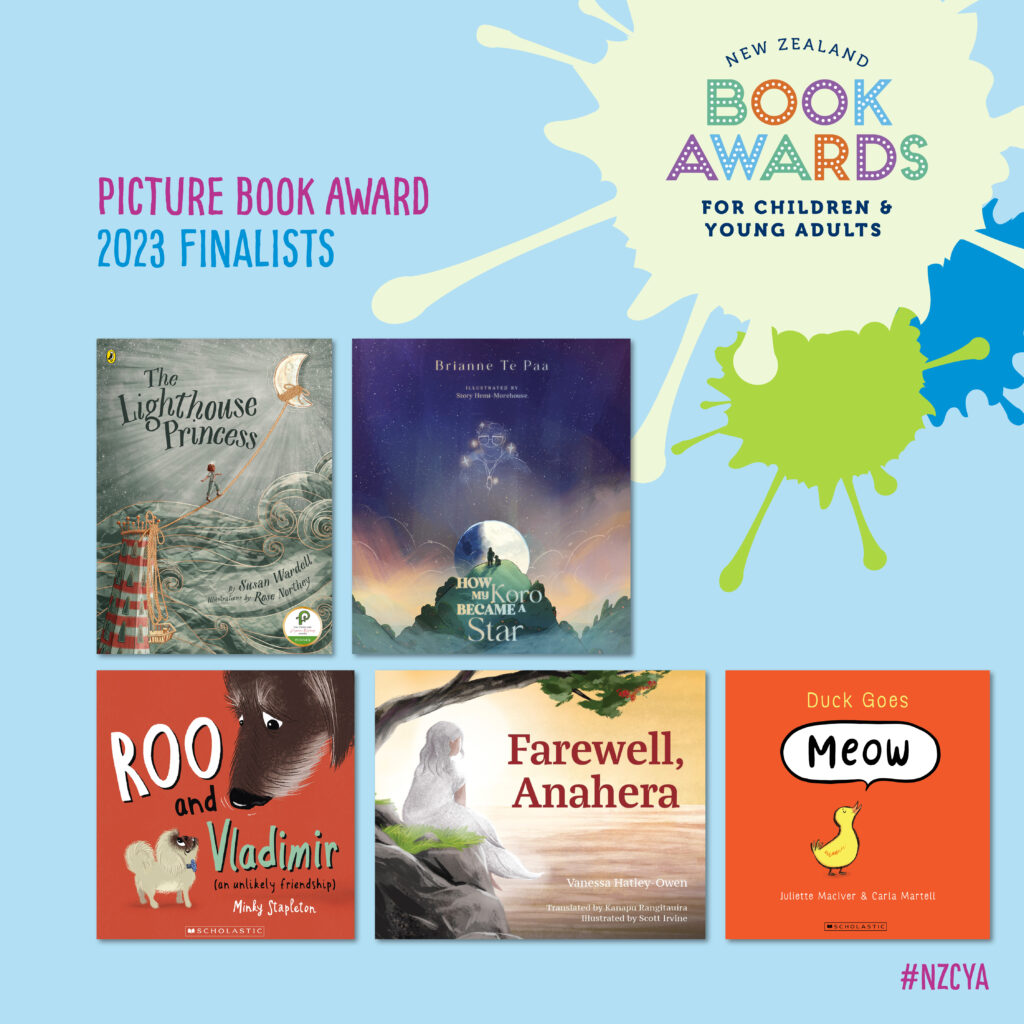
Duck Goes Meow, by Juliette MacIver & Carla Martell (Scholastic NZ)
A delightful tale of a little yellow duckling who is told by all the other animals that they are making the wrong sound. They are in for a big surprise when they finally meet Duck’s mama!
Farewell, Anahera, by Vanessa Hatley-Owen & Scott Irvine, translated by Kanapu Rangitauira (David Ling Publishing)
”Farewell, Anahera [is a bilingual Maori/English story that] follows the wairua (spirit) of Anahera as she journeys from her marae to Te Rerenga Wairua (Cape Reinga) and back to Hawaiki (her ancestral homeland).” Read more about this touching tale on the journey afterlife and its author Vanessa Hatley-Owen here.
How My Koro Became a Star, by Brianne Te Paa & Story Hemi-Morehouse (Huia Publishers)
Brianne’s heartwarming debut picture book follows a young boy’s journey learning about the significance of Matariki customs and his attempts to uphold them after the passing of his koro. Available in both English and te reo Māori, this beautifully illustrated story of coping with grief and loss, through family bonds and tikanga Māori, is a lovely read for young’uns and grown-ups alike.
Roo & Vladimir, by Minky Stapleton (Scholastic NZ)
Two very different dogs come into each other’s lives and they couldn’t be more delighted to be friends. A story where a misunderstood character finally gets really seen by the others around them.
The Lighthouse Princess, by Susan Wardell & Rose Northey (Penguin Random House NZ)
A beautifully illustrated not-your-classic-princess story with lots of New Zealand flavour and the writing is delightful. A princess is not stuck at her lighthouse and does not need rescuing, but when she rescues someone else she delights in having company. The Lighthouse Princess manuscript was chosen for the Storylines Gavin Bishop Award for Illustration in 2021, in which Rose Northey was the winner. It is a finalist in three categories (Best Picture Book, Russell Clark Illustration Award, and NZSA Best First Book).
Our picks to win:
Hannah: How My Koro Became a Star, by Brianne Te Paa & Story Hemi-Morehouse
Linda Jane: How My Koro Became a Star, by Brianne Te Paa & Story Hemi-Morehouse
Nida: How My Koro Became a Star, by Brianne Te Paa & Story Hemi-Morehouse
The Wright Foundation Esther Glen Award for Junior Fiction Finalists
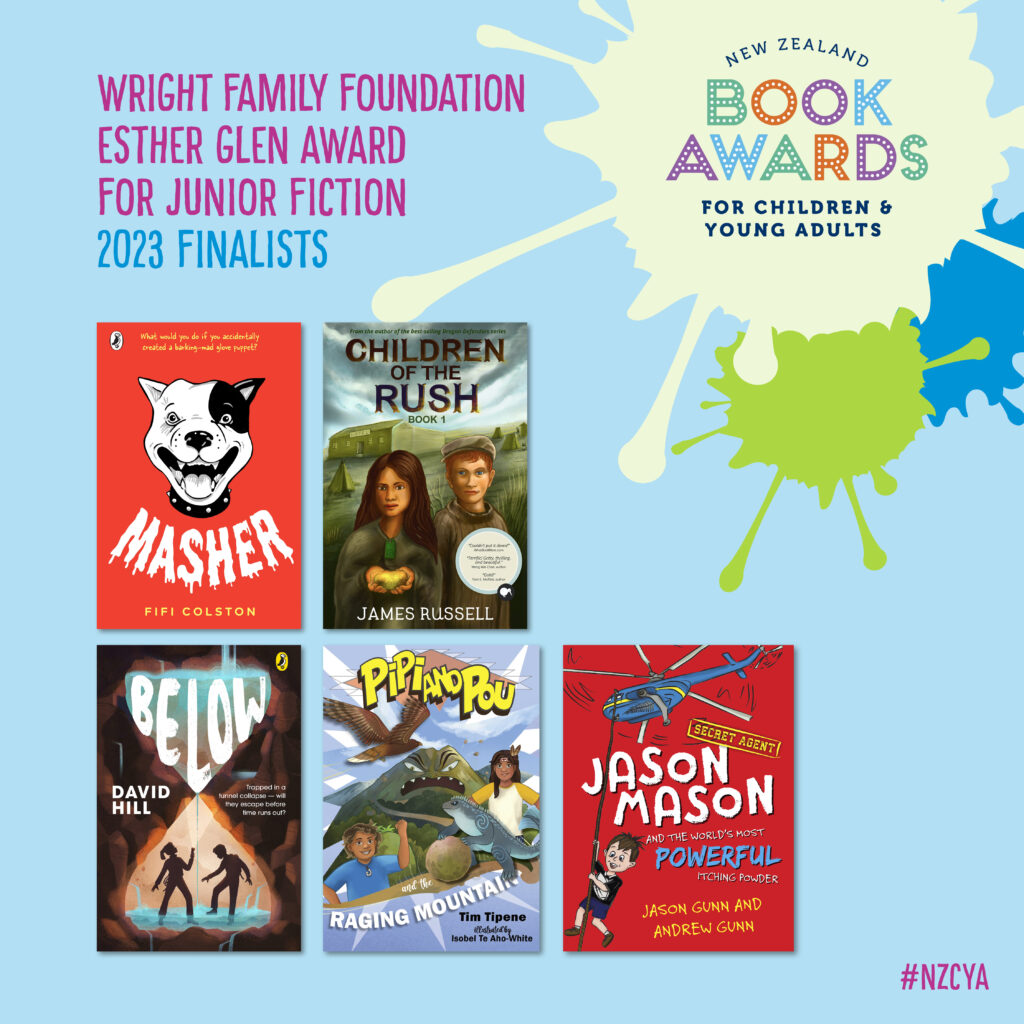
Below, by David Hill (Penguin Random House NZ)
“This book takes you underground and leaves you there, gasping for breath until the very end. It is pure David Hill, warts and all, with a pacy plot that will satisfy young readers. I highly recommend it, particularly for readers that need a bit of impetus in their books, and who are interested in tunnel engineering and environmentalism.” Read more from Sarah Forster’s review here.
Children of the Rush, by James Russell (Dragon Brothers Books)
“Children of the Rush is a fast-paced historical novel set during the first gold-rush inland of Dunedin in 1861 and marks [Russell’s] foray into something different. […] Aimed at 8-13-year-olds, [this novel] focuses on two young people and their experiences of the gold rush—one is a Māori girl, Atarangi, and the other is a Pākehā boy, Michael. I love the dyslexia-friendly font, the inclusion of te reo Māori words and phrases, and the extra activities and discussions at the end.” Read more from Lucy Black’s reviews here.
Jason Mason and the World’s Most Powerful Itching Powder, by Jason Gunn & Andrew Gunn (Bateman Books)
”For the generation of kids who will be too young to have known Jason Gunn from TV, Jason Mason introduces young readers to the humour and antics of one of NZ’s most prolific children’s presenters. [This] is a classic comedic book full of silly [and witty] jokes, including those of the fart variety, [with] plenty of Kiwiana [to] make [it] stand out. It’s sure to win over kids who otherwise wouldn’t read a book at all, which makes it a win for me, too.” Read more from Hannah Marshall’s review here.
Masher, by Fifi Colston (Penguin Random House NZ)
Fifi pulls the tale of the mishaps of Masher together with her characteristic humour and skill. The pace is perfect, and the illustrations are divine. AND you get instructions to build your own Masher. What more could you want?
Pipi and Pou and the Raging Mountain, by Tim Tipene & Isobel Joy Te Aho-White (OneTree House)
”Tim Tipene’s latest foray into junior fiction introduces us to the delightful world of cousins Pipi and Pou and their kuia Nana, and the adventures this trio of kaitiaki get up to. [They] show us that we don’t need supernatural abilities to be [guardians of] the environment and that protecting the natural world is rewarding, community-building, and fun. These books are sure to be a hit with kids and adults alike.” Read more from Hannah Marshall’s review here.
Our picks to win:
Hannah: Below, by David Hill
Linda Jane: Below, by David Hill
Nida: Masher, by Fifi Colston
The Young Adult Fiction Award Finalists
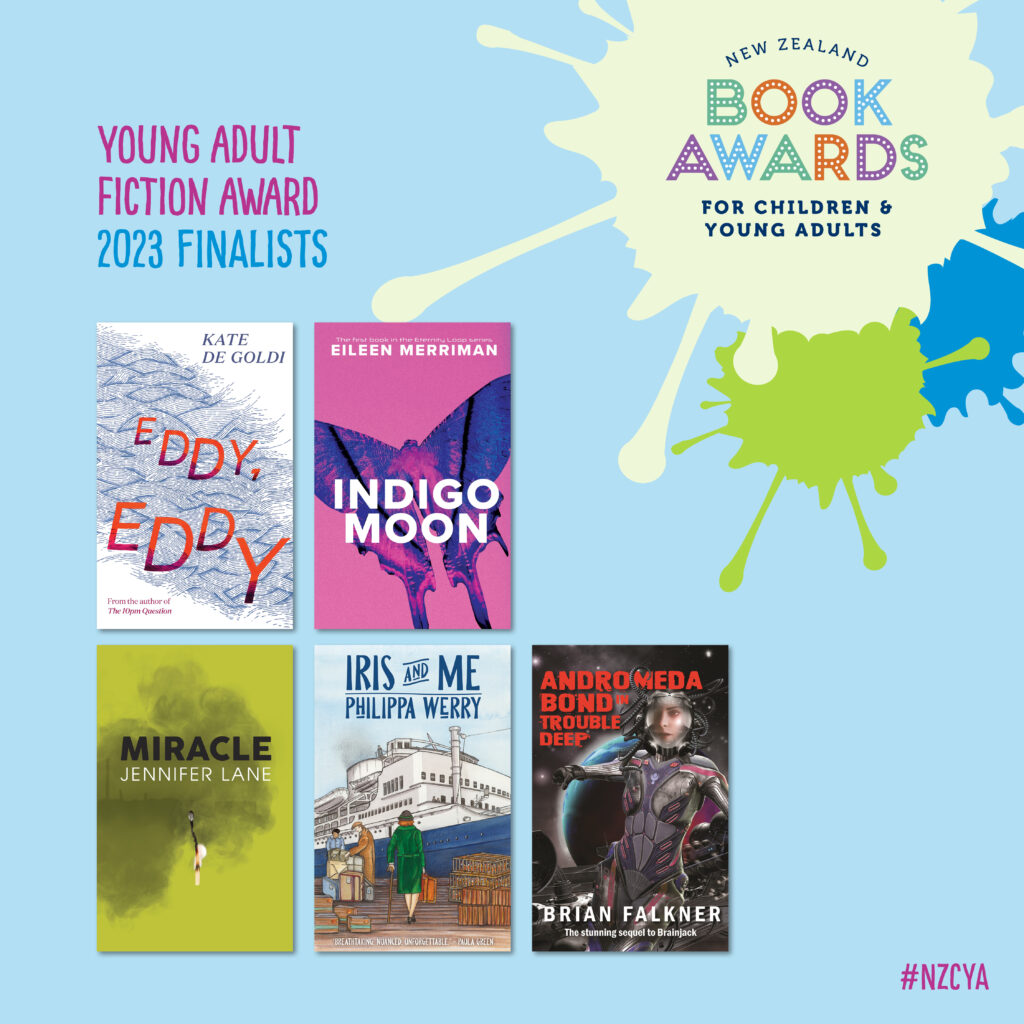
Andromeda Bond in Trouble Deep, by Brian Falkner (Red Button Press)
This sequel to Brainjack is set in the not too distant future, and tells the story of 12-year-old Andromeda being selected to play a live-streamed video game in space. Think Hunger Games but in zero gravity.
Eddy, Eddy, by Kate De Goldi (Allen & Unwin)
Kate De Goldi’s latest is a YA-adult crossover that takes us along the coming-of-age journey of 19-year-old Eddy Smallbone. Loosely inspired by A Christmas Carol and set over the festive period in post-earthquake Christchurch, Eddy, Eddy is a perfect read for older teens to delve into.
Indigo Moon, by Eileen Merriman (Penguin Random House NZ)
The first in the Eternity Loop series, Indigo Moon follows Offspring (enhanced humans) Rigel and Indigo on their teenage shapeshifting and time travelling lives. Their parents are the main characters in Merriman’s earlier Black Spiral trilogy. Read Sarah Forster’s review on Kete Books here.
Iris & Me, by Philippa Werry (The Cuba Press)
”Iris and Me by Philippa Werry is an imaginative account of the adventures of one of Aotearoa’s most significant writers, [Iris Wilkinson aka Robin Hyde] presented in a form that Hyde herself would have loved—the verse novel.” Read more from Philippa Werry and Juanita Deely’s author Q&A here and Sarah Forster’s review here.
Miracle, by Jennifer Lane (Cloud Ink Press)
”Set in the back blocks of NSW in the 1980s, Miracle follows 14-year-old Miracle and her family through various mysteries and violent acts, and the drama of being a teenage girl living amid poverty and depression.” Read more from Ceridwyn Robert’s review here.
Our picks to win:
Hannah: Iris & Me, by Philippa Werry
Linda Jane: Eddy. Eddy, by Kate De Goldi
Nida: Iris & Me, by Philippa Werry
The Elsie Locke Non-Fiction Award Finalists
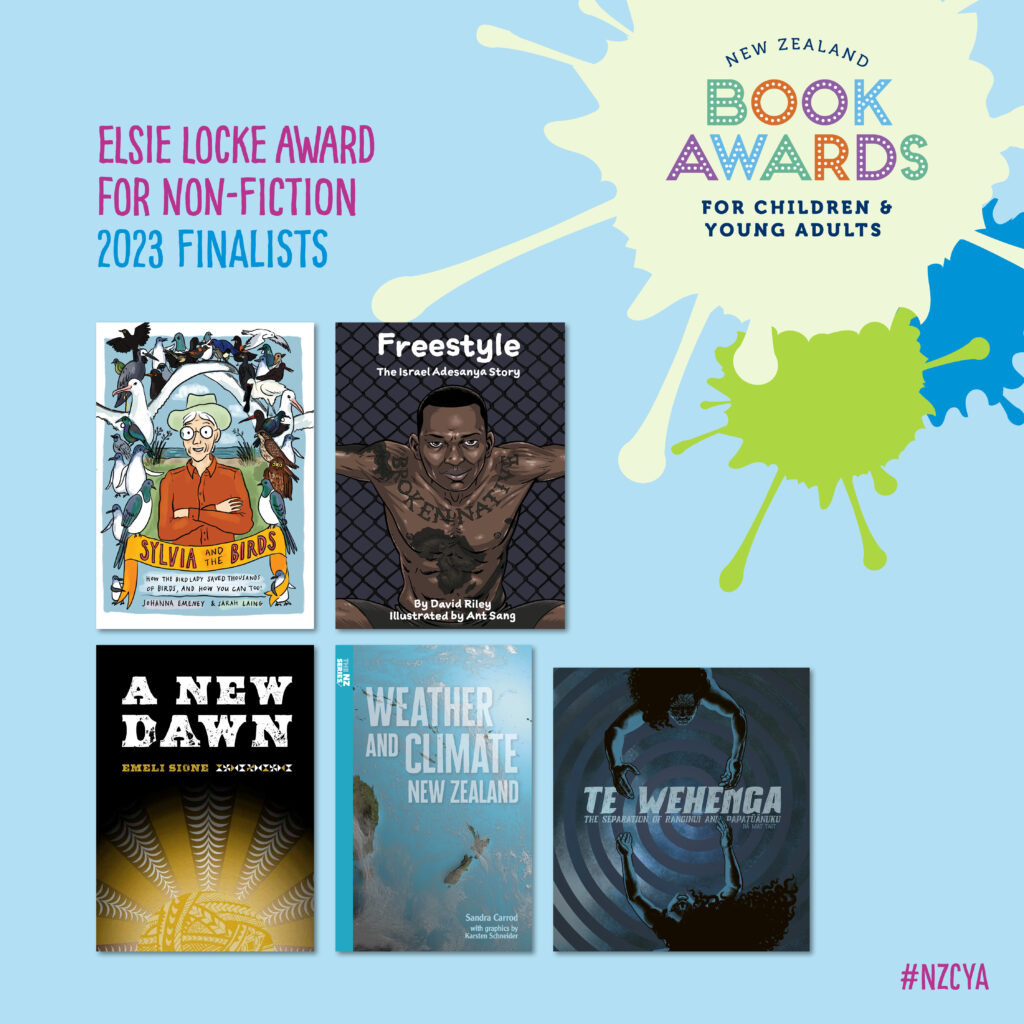
A New Dawn, by Emeli Sione & Darcy Solia (Mila’s Books)
”A New Dawn is a personal account of Emeli migrating to Aotearoa and her experience of the Dawn Raids. It is a beautifully written and personal story that humanises a really tough time in the history of Aotearoa, and Pacific peoples’ place within it. The book is […] an excellent learning resource for everyone, and I would highly recommend reading it to familiarise yourself with the reality that families who lived through this time faced.” Read more from Emmaline Pickering-Martin’s review here.
Freestyle: The Israel Adesanya Story, by David Riley & Ant Sang (Reading Warrior)
This is Adesanya’s life story and rise to sporting success told in a non-fiction format. Ant Sang’s dynamic art is the highlight of the book, showing the artist’s love of martial arts and comics action, but the story also has value for children with dyslexia by giving them an example of someone who shares their disability achieving their dreams.
Sylvia and the Birds, by Johanna Emeney & Sarah Laing (Massey University Press)
Sylvia and the Birds is an illustrated and photographic biography of Sylvia Durrant, aka The Bird Lady, as well as a conservation guide and activity book. Its format is annual-style; mixing up the storytelling in comics and prose, in between fact pages and banter between two kererū who are part narrators, part audience to the story itself. Read more from Linda Jane Keegan’s review here.
Te Wehenga, by Mat Tait (Allen & Unwin)
”Te Wehenga is an entirely bilingual retelling of the separation of Ranginui and Papatūānuku by their sons. The title itself literally means ‘The Separation.’ It is a story that anyone who has sat on a primary school mat in Aotearoa is familiar with, whether in Peter Gossage’s In the Beginning or some other iteration of the pūrākau. Tait may be known as an illustrator, but he knows what he’s doing with language—English and Māori alike. [His] retelling leans into the inherent lyricism of te reo Māori and takes that feeling into the English phrasing.” Read more from Briar Lawry’s review here.
Weather and Climate New Zealand, by Sandra Carrod (Oratia Books)
”Weather and Climate is the most recent title in The NZ Series and was highly commended in the Storylines Notable Book Awards. [It’s] a really good primer on climate and its drivers; starting with the bigger picture of climate effects – the Coriolis effect, greenhouse effect, atmospheric cells – and then working its way closer to the Earth, through ozone, carbon cycles and weather systems. The book concludes with actions you can take, as well as actions the government can take to reduce emissions.” Read more from Linda Jane Keegan’s review here.
Our picks to win:
Hannah: Sylvia and the Birds, by Johanna Emeney & Sarah Laing
Linda Jane: A New Dawn, by Emeli Sione
Nida: Te Wehenga, by Mat Tait
The Russell Clark Illustration Award Finalists
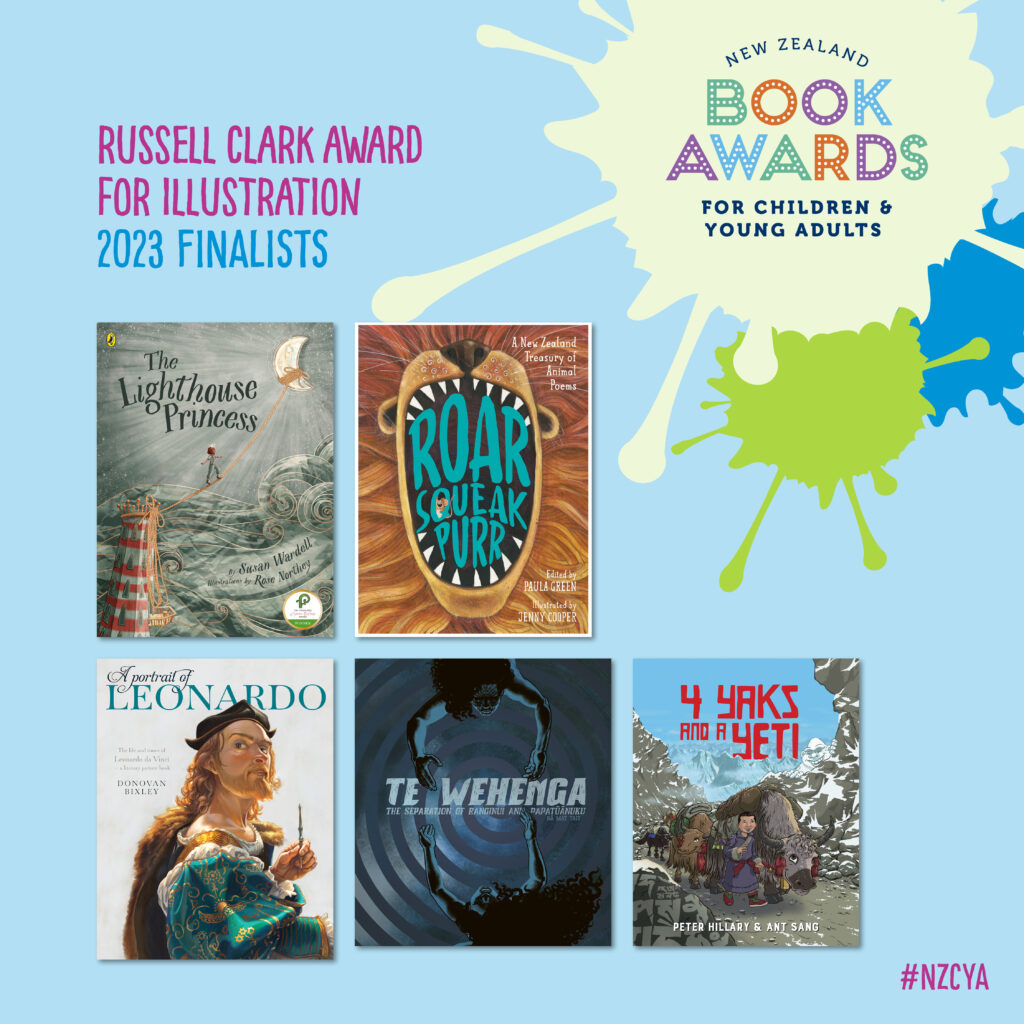
4 Yaks and a Yeti, illustrated by Ant Sang (Bateman Books)
“4 Yaks and a Yeti tells the story of Lhakpa, a Nepalese boy who, along with his four yaks, goes on a quest through the mountains to find Shangri-La. The story is both an adventure tale and a philosophical fable. The book was written by Peter Hillary, Chairman of the Himalayan Trust, son of Sir Edmund Hillary, and an accomplished mountaineer and philanthropist in his own right. A beautifully printed hardcover, 4 Yaks is a richly colourful book, accentuated with an embossed, foiled cover.” Read more from Eddie Monotone’s interview with Ant Sang here.
A Portrait of Leonardo, illustrated by Donovan Bixley (Upstart Press)
Bixley uses a range of illustration styles and rich detail to expertly portray the life and work of Leonardo da Vinci. Read Sarah Forster’s review on Kete Books here.
Roar Squeak Purr, illustrated by Jenny Cooper (Penguin Random House NZ)
Jenny Cooper’s illustrations are delightful in Roar Squeak Purr, “a stunning full-colour hardback collection of animal poems by top writers like Bill Manhire, Juliette MacIver, Joy Cowley and Apirana Taylor, as well as lots of poems written by children. It’s one of those books you give a child for Christmas and they’ll keep it for life.” Read Jane Arthur’s interview with the editor, Paula Green, here.
Te Wehenga, illustrated by Mat Tait (Allen & Unwin)
”Te Wehenga is an entirely bilingual retelling of the separation of Ranginui and Papatūānuku by their sons. The title itself literally means ‘The Separation.’ It is a story that anyone who has sat on a primary school mat in Aotearoa is familiar with, whether in Peter Gossage’s In the Beginning or some other iteration of the pūrākau. Tait may be known as an illustrator, but he knows what he’s doing with language—English and Māori alike. [His] retelling leans into the inherent lyricism of te reo Māori and takes that feeling into the English phrasing.” Read more from Briar Lawry’s review here.
The Lighthouse Princess, illustrated by Rose Northey (Penguin Random House NZ)
A beautifully illustrated not-your-classic-princess story with lots of New Zealand flavour and the writing is delightful. A princess is not stuck at her lighthouse and does not need rescuing, but when she rescues someone else she delights in having company. The Lighthouse Princess manuscript was chosen for the Storylines Gavin Bishop Award for Illustration in 2021, in which Rose Northey was the winner. It is a finalist in three categories (Best Picture Book, Russell Clark Illustration Award, and NZSA Best First Book).
Our picks to win:
Hannah: Roar Squeak Purr, illustrated by Jenny Cooper
Linda Jane: Te Wehenga, illustrated by Mat Tait
Nida: A Portrait of Leonardo, illustrated by Donovan Bixley
The Wright Family Foundation Te Kura Pounamu Award for Te Reo Māori Finalists
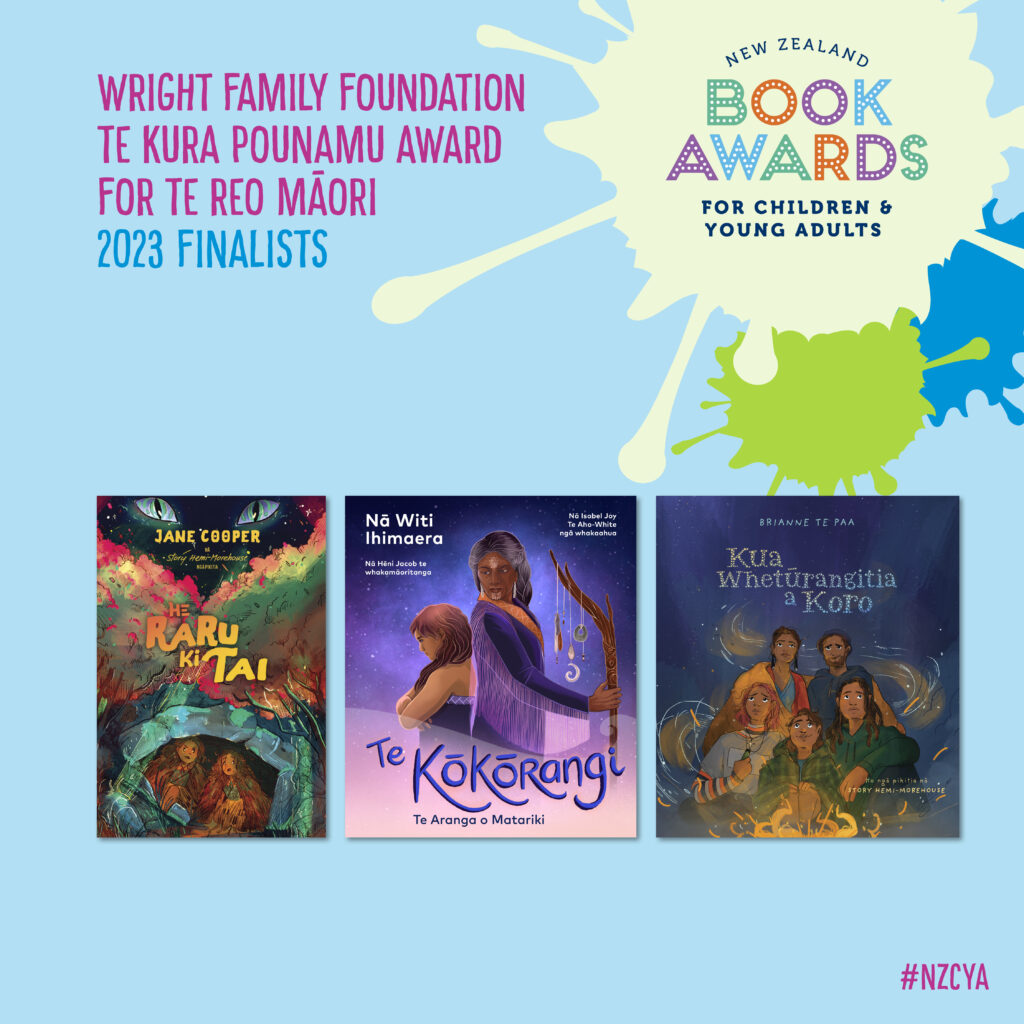
He Raru ki Tai, by Jane Cooper & Story Hemi-Morehouse (Huia Publishers)
Te reo Māori edition of To Trap a Taniwha. It’s the 1600s in Tāmaki Makaurau and two girls are on a dangerous mission to defy the actions of their leaders. He Raru ki Tai is a finalist in two categories—the Wright Family Foundation Te Kura Pounamu Award for Te Reo Māori, and NZSA Best First Book.
Kua Whetūrangitia a Koro, by Brianne Te Paa & Story Hemi-Morehouse (Huia Publishers)
Te reo Māori edition of How My Koro Became a Star. Brianne’s heartwarming debut picture book follows a young boy’s journey learning about the significance of Matariki customs and his attempts to uphold them after the passing of his koro. Available in both English and te reo Māori, this beautifully illustrated story of coping with grief and loss, through family bonds and tikanga Māori, is a lovely read for young’uns and grown-ups alike.
Te Kōkōrangi, by Witi Ihimaera & Isobel Joy Te Aho-White, translated by Hēni Jacob (Penguin Random House NZ)
Te reo Māori edition of The Astromancer. Te Kōkōrangi is an Astromancer (one who studies stars) on a mission to find new apprentices with whom to share her teachings. Ihimaera covers ground from Te Kore to the ancestry of the star clusters, while one of the recruits faces their own challenges.
Our picks to win:
Hannah: He Raru ki Tai, by Jane Cooper & Story Hemi-Morehouse
Linda Jane: Te Kōkōrangi, by Witi Ihimaera & Isobel Joy Te Aho-White
Nida: He Raru ki Tai, by Jane Cooper & Story Hemi-Morehouse
The NZSA Best First Book Award Finalists
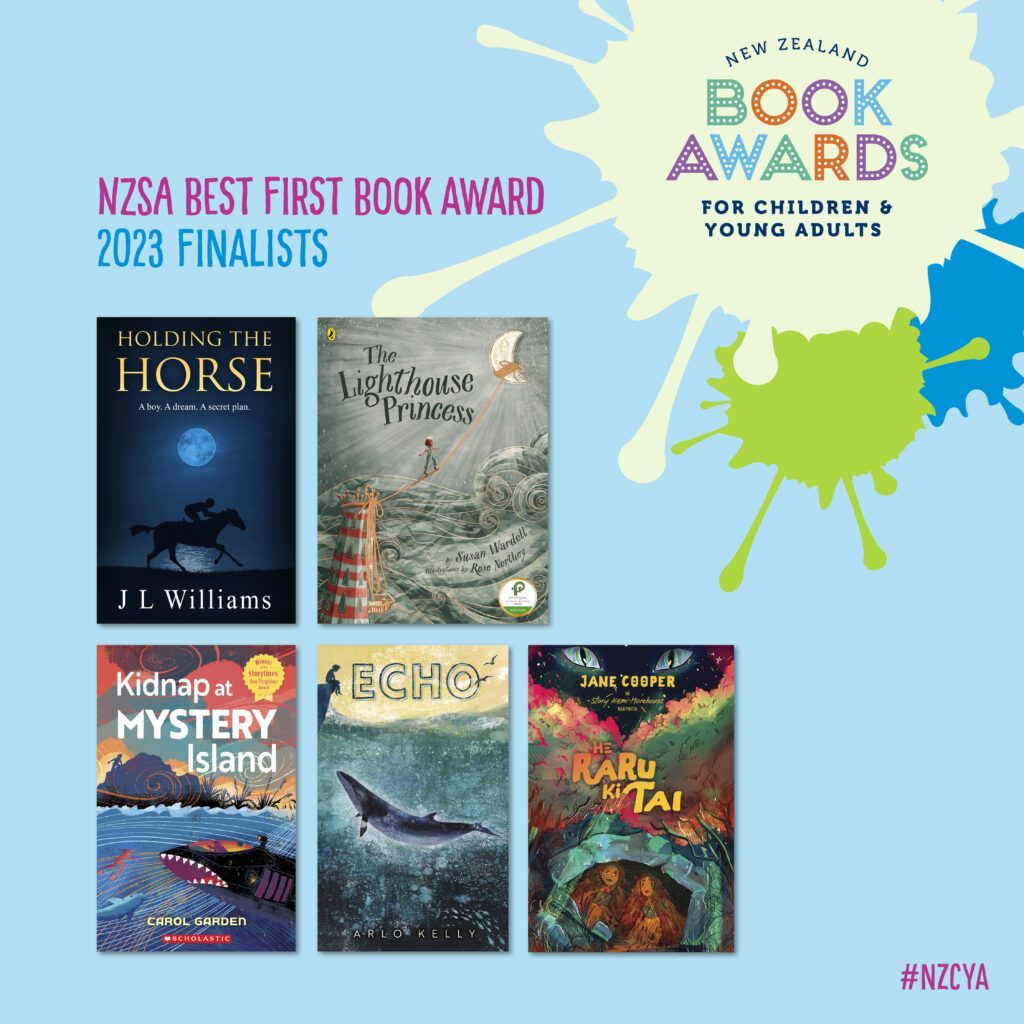
Echo, by Arlo Kelly (Sparrow Press)
One of the Awards’ youngest ever finalists, Arlo Kelly brings a story of visually impaired kid who has a chance interaction and then special connection with a minke whale.
Holding the Horse, by J L Williams (Ocean Echo Books)
Set in post-WWII New Zealand, Holding the Horse is a story about following your dreams, with all kinds of twists and turns along the way. You don’t have to be a horse person to love it!
He Raru ki Tai, by Jane Cooper & Story Hemi-Morehouse (Huia Publishers)
Te reo Māori edition of To Trap a Taniwha. It’s the 1600s in Tāmaki Makaurau and two girls are on a dangerous mission to defy the actions of their leaders. He Raru ki Tai is a finalist in two categories (Wright Family Foundation Te Kura Pounamu Award for Te Reo Māori, and NZSA Best First Book.
Kidnap at Mystery Island, by Carol Garden (Scholastic NZ)
”This [is a] futuristic book, set in the ‘New World’ where our earth is conserved and all technology is created with its end use in mind […] to help humans live in harmony with the land. […] It’s refreshing to read something set in a world where all our climate troubles have been resolved—there is no racism, no sexism, the economy is circular, and everyone lives peacefully. Unless they are baddies.” Read more from Sarah Forster’s review here.
The Lighthouse Princess, by Susan Wardell & Rose Northey (Penguin Random House NZ)
A beautifully illustrated not-your-classic-princess story with lots of New Zealand flavour and the writing is delightful. A princess is not stuck at her lighthouse and does not need rescuing, but when she rescues someone else she delights in having company. The Lighthouse Princess manuscript was chosen for the Storylines Gavin Bishop Award for Illustration in 2021, in which Rose Northey was the winner. It is a finalist in three categories (Best Picture Book, Russell Clark Illustration Award, and NZSA Best First Book).
Our picks to win:
Hannah: The Lighthouse Princess, by Susan Wardell & Rose Northey
Linda Jane: He Raru ki Tai, by Jane Cooper & Story Hemi-Morehouse
Nida: The Lighthouse Princess, by Susan Wardell & Rose Northey







